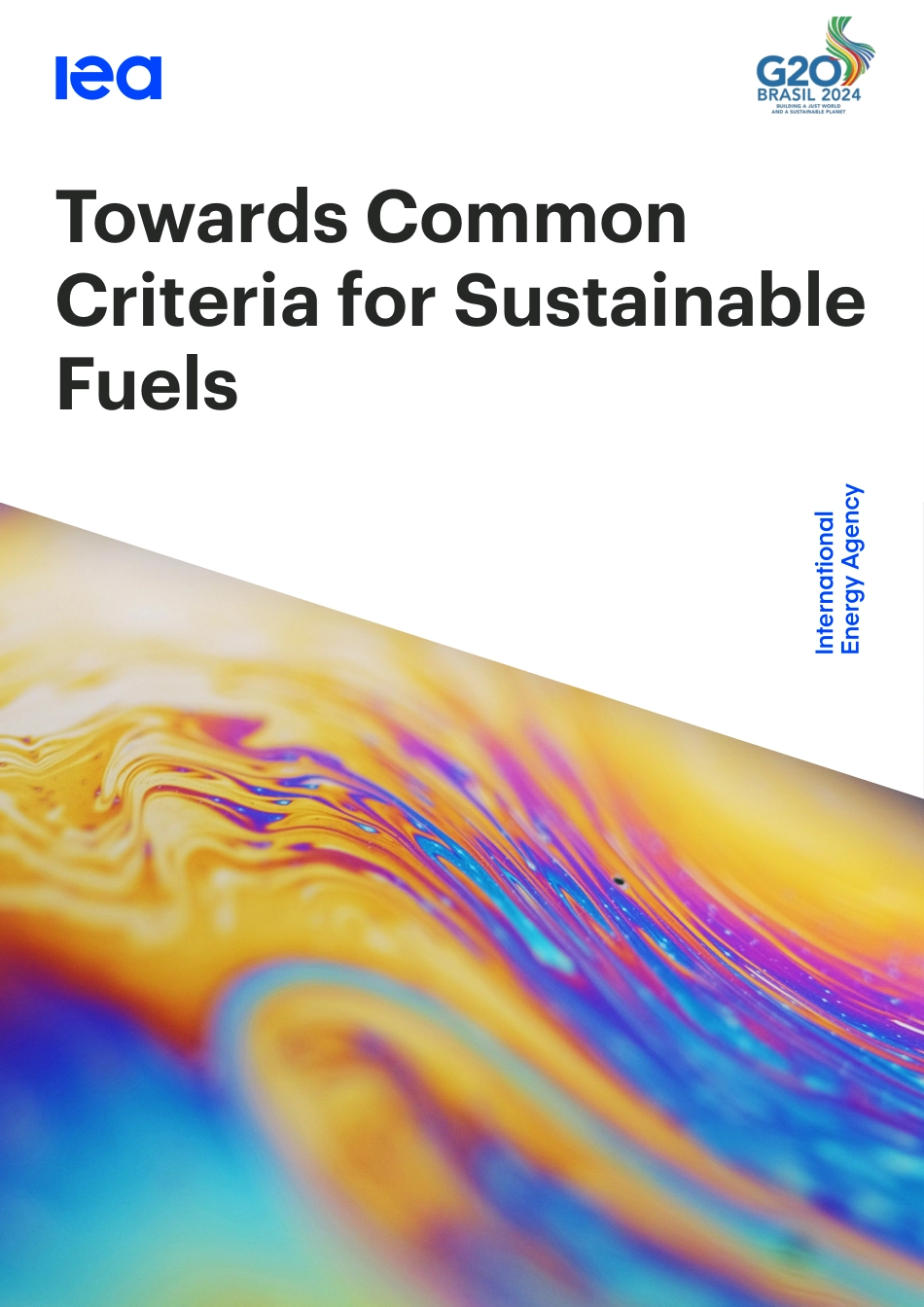TowardsCommonCriteriaforSustainableFuelsTheIEAexaminesthefullspectrumofenergyissuesincludingoil,gasandcoalsupplyanddemand,renewableenergytechnologies,electricitymarkets,energyefficiency,accesstoenergy,demandsidemanagementandmuchmore.Throughitswork,theIEAadvocatespoliciesthatwillenhancethereliability,affordabilityandsustainabilityofenergyinits31membercountries,13associationcountriesandbeyond.Thispublicationandanymapincludedhereinarewithoutprejudicetothestatusoforsovereigntyoveranyterritory,tothedelimitationofinternationalfrontiersandboundariesandtothenameofanyterritory,cityorarea.Source:IEA.InternationalEnergyAgencyWebsite:www.iea.orgIEAmembercountries:AustraliaAustriaBelgiumCanadaCzechRepublicDenmarkEstoniaFinlandFranceGermanyGreeceHungaryIrelandItalyJapanKoreaLithuaniaLuxembourgMexicoNetherlandsNewZealandNorwayPolandPortugalSlovakRepublicSpainSwedenSwitzerlandRepublicofTürkiyeUnitedKingdomUnitedStatesTheEuropeanCommissionalsoparticipatesintheworkoftheIEAIEAassociationcountries:ArgentinaBrazilChinaEgyptIndiaIndonesiaKenyaMoroccoSenegalSingaporeSouthAfricaThailandUkraineINTERNATIONALENERGYAGENCYRevisedversion,October2024Informationnoticefoundat:www.iea.org/correctionsTowardsCommonCriteriaforSustainableFuelsAbstractPAGE|3IEA.CCBY4.0.AbstractSustainablefuelsplayacrucialroleincleanenergytransitions.Theycomplementdirectelectrificationandenergyefficiencymeasuresindecarbonisingsectorsforwhichemissionsarehardtoabate,whilecontributingtoenergydiversificationandsecurity.UndertheIEA’sNetZeroEmissionsby2050(NZE)Scenario,thedemandforlow-emissionfuelssuchasliquidbiofuels,biogases,hydrogenandhydrogen-basedfuelswouldneedtodoublefromcurrentlevelsby2030anddoubleagainby2050.Despitetheirimportance,noneofthemainsustainablefueloptionsareontrackforanetzeropathway.Accelerateddeploymentofsustainablefuelsdependsinpartonachievingacommonunderstandingofwhatmakesafuel“sustainable”.Numerousframeworksandcertificationschemesforsustainablefuelshavebeenestablishedworldwide.Termssuchas“green,”“blue,”or“advanced”arefrequentlyusedtodescribethesustainabilityfeaturesoffuelsandtodifferentiatethemfromtheirunabatedfossilcounterparts.However,thereisnointernationalconsensusonthemeaningoftheseterms.Theirdefinitionsareinconsistentand,critically,theydonotusuallyprovidequantitativeinformationaboutgreenhousegasemissions.Thisreport–producedinsupportofBrazil’sG20Presidency–exploresthefeasibilityandimplicationsofsettingupcommoncriteriatoenablefaircomparisonsofsustainablefuels.Itmapscommonalitiesanddifferencesamongthestandards,regulationsandcertificationsusedforsustainablefuelsacrossdifferentregionsandmarkets.Itreviewstypicalcarbonintensitiesandtheimprovementpotentialofvariousfuelproductionpathwaysandsetsoutpolicyconsiderationsforgovernmentsthatwishtoworktowardcommoncriteriaforsustainablefuels.TowardsCommonCriteriaforSustainableFuelsAcknowledgementsPAGE|4IEA.CCBY4.0.Acknowledgements,contributorsandcreditsThisreportwaspreparedjointlybytheRenewableEnergyDivisionandtheEnergyTechnologyPolicyDivisionoftheInternationalEnergyAgency.ThestudywasdesignedanddirectedbyPaoloFrankl,HeadoftheRenewableEnergyDivision.SeniorEnergyAnalystIlkkaHannulawastheleadauthorofthereportandcoordinateditsproduction.Otherauthorswere(inalphabeticalorder)AnaAlcalde,JoseBermudez-Menendez,HeribBlancoandPaoloFrankl.Thereportbuildsuponandexpandsona...



 VIP
VIP VIP
VIP VIP
VIP VIP
VIP VIP
VIP VIP
VIP VIP
VIP VIP
VIP VIP
VIP VIP
VIP